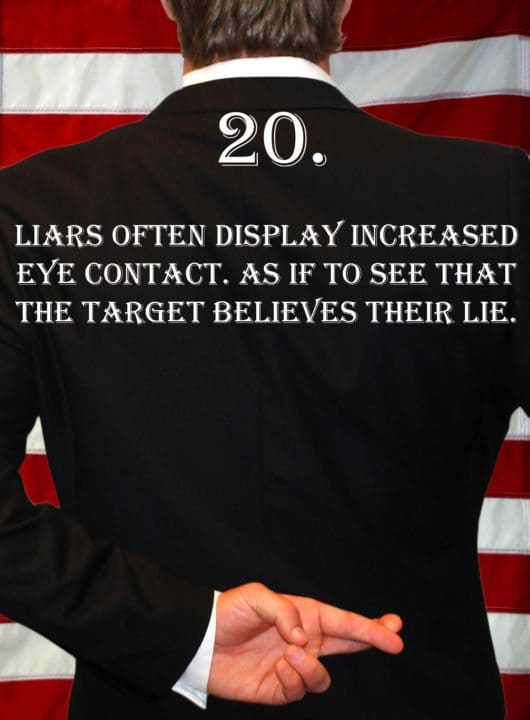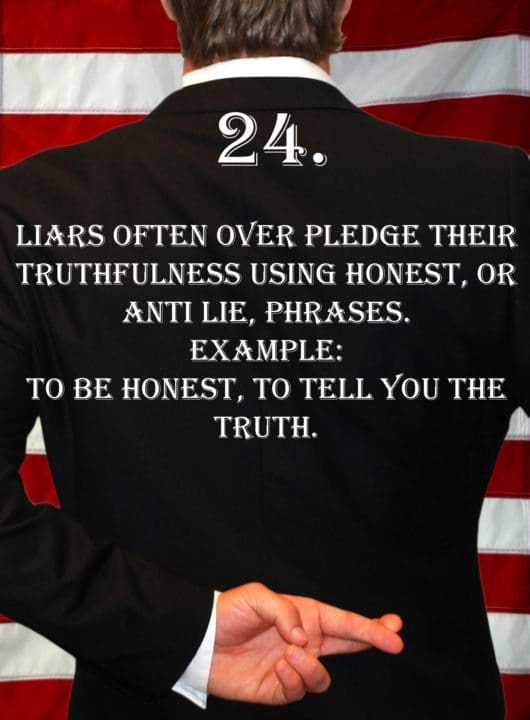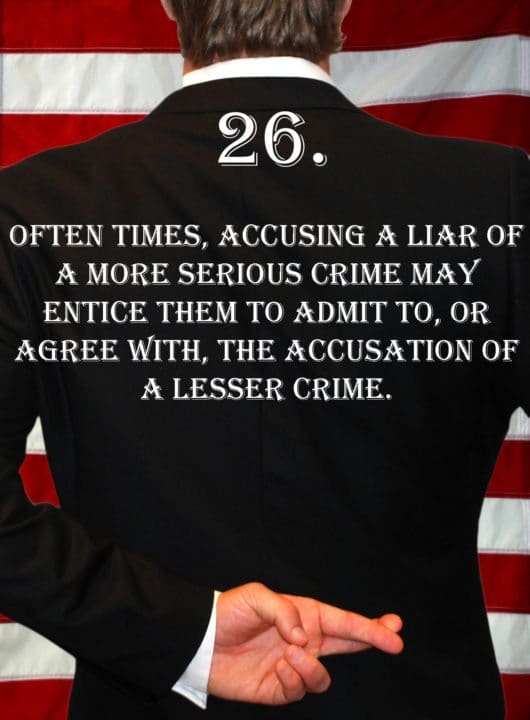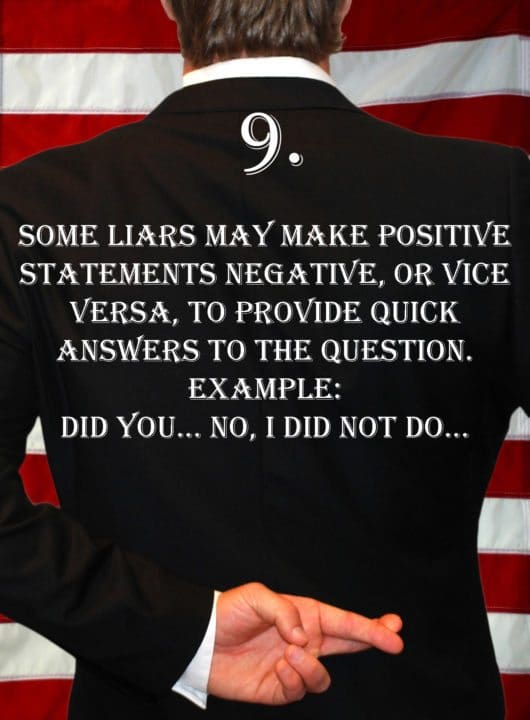
Deception Tip 20:
Liars often display increased eye contact. As if to see that the target believes their lie.
Listen To The Podcast!
E20 – Eye Contact – Deception Tips Podcast – Click Here To Subscribe
Podcast Transcript
Hello, and welcome to the Deception Tips Podcast, where you will learn amazing cues to detect deceit that will help you read people like never before. I’m your host, Spencer Coffman. Let’s get started.
Hello and welcome to episode 20 of The Deception Tips Podcast. Thanks for tuning in, once again, this week. Last time, we spoke of an emotion that is displayed asymmetrically on the face. It is the only emotion that shows up asymmetrically on the face.
We have also talked about how symmetrical facial expressions and gestures often indicate truthfulness. That is true. They do indicate truthfulness and they are what you need to watch for when determining whether someone is telling the truth or a lie.
If their expressions, their body movements, their speech and actions, things like that are congruent and symmetrical there is a greater chance that they are telling the truth. However, if things are asymmetrical or incongruent, whereas they do something or say something that doesn’t match up; their gestures don’t match their words/how they’re speaking/etcetera, then there is a greater chance they are being deceptive. However, when it comes to contempt, that expression is shown asymmetrically on the face.
In addition, it is more predominant on the right side of the face. This is because the left side of the brain controls the right side of the body and the right side of the brain controls the left side of the body. So, they are contralaterally related.
This means that if people are showing emotions on the right side of the face, that comes from the left brain or the left cerebral hemisphere. This is typically the more truthful side of the brain. Whereas the right side of the brain is typically more active in false/deceptive emotions. This is why asymmetricality is more predominantly displayed on the left side of the face.
Therefore, contempt being an asymmetrical truthful emotion, would by the reasoning of this, show up more on the right side of the face. Therefore, when you see someone having a half of a smile or a contemptuous look. That’s what contempt looks like.
It’s kind of a half-smile or a corner of the mouth goes up. That will be on the right side of the face. If you see it there, that’s more truthful. Oftentimes, contempt is disguised with a smile. Therefore, you would most likely see the contempt flash across the face.
Now, by “flash across the face,” I’m talking like a micro-second- maybe a quarter of a second at most- with the contempt showing up, and then they’re going to mask it with a smile. Which means the left side of the face is going to match that contemptuous look.
So now, it’s going to appear if they’re smiling instead of being contemptuous. That is the right brain being a little bit deceptive making the left side of the face match that so that you don’t see the contempt. It’s an attempt to conceal that. That is the deception in action.
Otherwise, contempt is a truthful emotion and it shows up asymmetrically. It is one of the only emotions- the only emotion- that shows up with asymmetricality on the face. So, watch out for that. If you start noticing asymmetrical expressions, and it isn’t contempt, then it is most likely that that person is being deceptive.
Today, we are going to talk about a myth when it comes to lie detecting and deception. This is a very popular myth. You see it all the time. You hear about it all the time. Many, many people believe it. And, many people use it to try to determine whether or not someone is lying.
What they don’t know is that by using this myth, they are actually hurting themselves. They are giving the liar an “out.” They are allowing the liar to show the leakage and they are believing that the leakage is, in fact, truthful expressions instead of deceptive expressions.
This form of leakage is a form of eye contact. This is where people often say, “Look me in the eye so I know you’re telling the truth.” However, this is really not a good thing to do because, as you’ll find out today, when people look other people in the eye they, oftentimes, could be lying.
So, lying and eye contact is not really a great indicator of deception or whether or not someone is telling the truth. There is a lack of contact or other eye movements that will help you determine and detect deception, but having someone look someone in the eye to determine whether or not they are telling the truth is generally not a good practice.
The reason you may have heard this before is that when you are looking someone in the eye the target, or the person reading the liar, is not often looking right at the eyes. They are usually looking at the whole face so that they can see all of the expressions.
So here it is. Deception Tip 20: Liars often display increased eye contact as if to see that the target believes their lie. Here it is again. Liars often display increased eye contact as if to see that the target believes their lie.
So, liars have one goal. And that is to make sure that the target believes what they are saying. They want to get away with something or pull one over on somebody, etcetera. Their goal is to be believed. Not only that, but they want to believe in themselves. So, they’re also trying to convince themselves of the lie. We’ve talked about this before.
They are trying to convince themselves and the other people of their lies. So, when they are talking to someone else, their goal is to see and convince themselves of the lie and that the target believes their lie.
So, they want to know that they have convinced you or that they have convinced whomever they are lying to. That is a huge thing for them and it is a big form of satisfaction.
When we talked about contempt last week, we mentioned that when people show contempt that it’s often because they are convinced, or because they are convinced that the target has believed them, or that they have “won” or pulled one over on the target. It’s a contemptuous look. It’s one of- “Man! You’re an idiot!” Something like that. “Ha! I fooled you!” So, they show that look of contempt.
Liars often display increased eye contact so that they can watch themselves fool the target. They want to fool that target, and by watching them and showing them and seeing all of this, they are better able to watch the target be fooled. If, in fact, the target is going to be fooled. So, that is why they display increased eye contact. We’re going to talk a lot more about this, coming up next.
Want to be a human lie detector but don’t have the brains or the guts to do it? We understand. That’s why we created The Deception Tips Blog– especially for you. Check it out today on spencercoffman.com.
“Look me in the eye so I know you’re telling the truth.” That statement is one that gives liars a reason to rejoice. They know that if they can look someone in the eye, and watch to see if that person believes the lie, they will be at so much more ease with themselves than if they are not made to look them in the eye.
When liars, unconsciously, know that the target is looking at their eyes, they display so much relief because now they know that any other form of leakage on the body is not going to be seen.
If you are only focusing on someone’s eyes, you’re missing probably 99% of the signs- man, probably 99.9% of the signs of deception. We’ve talked about- today is 20- so we’ve talked about 20 different signs of deception. How many of the 20 have been related to the eyes?
We had dilated pupils way back in episode 2 and that- that is it. I mean you could maybe say symmetrical expressions could be partly related to the eyes, but that is really it. We have had 1- 1 out of the last 20 signs that have been directly related to the eyes! You could count today as being related to the eyes but I’m talking about an expression of eye movement or eye behavior so to speak. There has only been 1 out of the last 20.
That means that if you are only focusing on the eyes, as of today with all these signs, you’d have a 1 in 20 chance of spotting a liar or spotting a sign of deception. That is AWFUL!
That is terrible because there is more than one sign. Every time there is always- ALWAYS- more than one sign of deception happening on someone’s body. Therefore, if you’re only watching the eyes you’re only going to see 1 sign of deception.
So, if they have so many signs: dilated pupils, stepping backward, folding their arms, crossing their legs, all this stuff, gestures, quick answers, things like that. You’re going to miss all of those other signs because you’re only watching the eye. Now, this is very important.
Liars love this. So, if you tell someone, “Look me in the eye so I know you’re telling the truth.” Boom. They may not consciously realize that that’s a big thing for them, but they will unconsciously know it.
Now, this could create a little bit of confusion with you because I’ve said the unconscious is truthful. Yes. The unconscious is very truthful. The conscious tells the lie. But, when the liar is battling between the conscious and the unconscious, the unconscious is trying to leak the truth and the conscious knows that it’s going to tell the lie.
So, by giving them an out by saying, “Look me in the eye,” they consciously are going to tell that lie and they unconsciously are going to try to leak more behaviors. But, there’s going to be a little bit of peace.
They’re not consciously thinking that “Oh good! He told me to look him in the eye so now I can leak other behaviors and he’ll not see it.” No. They’re not consciously thinking that. But, a part of their unconscious, and a part of their conscious- there’s kind of a medium there- that is kind of in agreement with it. They take a breath, a sigh of relief, saying, “Whew! I’m glad that now I can leak the other behaviors elsewhere and not be seen.”
Now, it’s not the unconscious that says this, and it’s not directly in their front thought process, but it’s a portion of the conscious. It’s the unconscious portion of the conscious. It’s kind of confusing.
All of this, in psychological terms, really would be more considered a pseudo-science because anyone is going to tell you that the conscious doesn’t have a part of the unconscious. It is only conscious and unconscious. It doesn’t make sense that they have multiple parts. But, in order to describe it for easily understanding what is going on, that is the best way to kind of come up with it.
They’re not consciously thinking to themselves, “Oh good! Now when I leak behaviors unconsciously they won’t see those behaviors because they’re only looking at my eyes.” Yet, the unconscious is more truthful, so it’s not thinking, “Oh good! Now they won’t see my behaviors.”
Because that’s not what it’s thinking either. So, it’s the portion of the conscious that is saying, “Whew! Now I can relax because now I know that they won’t see that pesky unconscious who’s trying to be truthful.”
Hopefully, you understand that and kind of grasp the situation. Because really what it is, is it’s allowing the liar to have an out. It’s like saying, “Well! You tell me a lie, but I won’t look at you at all.”
So now the liar knows that all they have to do is focus on their voice and make sure that they mask those situations and those expressions in the vocal. But now, when you’re looking at the eyes they know, “Well! All I need to do is maintain good solid eye contact. Why? Because they said they’d believe me if I look them right in the eye.”
Usually, liars maintain good eye contact anyway because they want to watch the target believe their lie. Liars are somewhat of a narcissistic personality trait when they’re being liars- when they’re telling the lie.
They get a little bit of pleasure and enjoyment out of fooling someone or convincing someone, of their lie. It makes them feel a little bit good- a little bit of a high on that because they know that their story was convincing enough.
How are they going to know that person believed them if they’re not watching them- if they are not looking at them- watching and seeing their reactions to their story and seeing how they believe what is being said? They can’t. The only way they would know is if that person gave some kind of a verbal confirmation so they could hear it. Which, they’re always listening. They’re always hearing.
It’s funny because we say, “Maintain good eye contact.” What about maintaining good listening awareness? Well, we’re always hearing things. We may not be listening to them but we’re hearing them all the time. So, a liar is already always listening for verbal confirmations from the target but they’re not always watching.
So, if a target says, “give me some good eye contact,” or “look me in the eye.” Now, the liar is maintaining great eye contact with an excuse and is listening. So, they have two great ways to know that the target is believing their lie.
So, pay attention to this because liars will often display increased eye contact. You may be wondering why that person is looking at you so intently when they’re telling their story. So, pay attention to this when you’re interacting with people whether at work, at home, with your family, at the grocery store, at social interactions, anywhere, at meet-n-greets, etcetera.
Watch how other people- number 1: interact with each other and notice where their eyes go, and what they’re looking at. And then pay attention to yourself and how you interact with other people when you’re talking to them and watch where your eyes go and where their eyes go.
Most of the time, the whole field of vision is worked. This means you look around at all the different things. You may look at their watch, their tie, their clothes, this, that, the person behind them, etcetera.
Very rarely are you always gazing deep into their eyes. In fact, try this one time. Look directly in someone’s pupils for five seconds. See what happens and how it makes you feel. This way you’ll kind of know that there is a certain comfort level there.
And when liars are doing that and displaying that increased eye contact you will know, now after trying that test, why that is such a red flag. Because staring into someone’s eyes, unless you really love them- so don’t do it with your spouse or with your significant other.
Do it with someone else who is kind of an acquaintance or something like that. Because it is a feeling that is for deep emotion- when you’re staring directly into someone’s eyes. It’s like a soul-gazing experience. The eyes are the windows to the soul. So, when you do that, it’s not something you do normally in everyday conversation.
I want to thank you for listening to this week’s episode of the Deception Tips Podcast. I encourage you to share it with your friends, subscribe to the feed, check out the Deception Tips Blog, and take a look at the books I have available. And, as always, tune in next week for a new Deception Tip.
Video Transcript
Hey guys, my name is Spencer Coffman. Thank you for watching the Deception Tips Videos, they’re all about teaching you how to read people and detect deception so that you will be able to tell if someone is lying to you.
Today, we are going to talk more about deception and how you can see it, and when you can know if someone is lying to you or whether or not they are telling the truth. Today, we’re going to talk about eye contact. Now, eye contact is something that is hugely important in everyday conversation.
It’s something that when you are talking to other people, you’re looking at them and they know that you mean what you’re saying, and then that eye contact instantly adds credibility and authority, and all kinds of things like respect. And it’s easier for you to have eye contact when you’re listening than when you are talking. For example, you’re watching these videos and you’re looking right at the screen. You’re looking at me, and I, and you see that my eyes are looking right at you in your eyes.
So this is Deception Tip number 20, and it is all about eye contact. Liars often display increased eye contact. As if to see that the target believes their lie.
So when someone is lying, they want to make sure that the target, or the person that they are lying to, will believe their lie. After all, that is the reason that they are lying in the first place. They have a goal, and that goal is, number one, to be believed. And number two, to get away with whatever they are trying to get away with. And inside of them, they have a burning desire to let that lie out. They are being filled with all kinds of stress, and tension, and things like that.
They are very anxious, and they have a lot of anxiety, and as you’ve learned already in a lot of these other videos, that this anxiety kind of boils up, and they can’t wait to get that out. And this is often why there’s a lot of nonverbal leakage that happens with the conscious and the unconscious, and they’re battling one another. They are head-to-head fighting.
The conscious is trying to get away with this lie and the unconscious is leaking out all of these truthful behaviors so that someone else can see, and see through that lie. So when a liar is lying, they will display increased eye contact. Now, this is a huge portion of detecting deception, because a lot of people believe that if you are looking someone in the eye, then you know that they’re telling the truth.
How often do you hear that? “Look me in the eye, so I know you’re telling the truth.” However, this is a myth. It is a huge myth because when a liar is lying, they will look you right in the eye because they want to watch you believe the lie. They want to see that you are being fooled. They have that desire to know whether or not you are going to believe that lie and whether or not they are going to get away with it.
So often times as they tell that lie, if, if the target doesn’t know any better, and they say, “look me in the eye so I know you’re telling the truth,” you have just given that liar a big sigh or a big breath of relief, because now that they know that they can look you in the eye without feeling suspicious, or without you getting suspicious. When the liar looks at the target in the eye, they know that they have a much better chance to get away with that lie.
So if you are the person who has said, “look me in the eye so I know you’re telling the truth,” now you need to rely on other signs of deception because there will be some. You may see a little sign of contempt after that. So, you could, even if you’re interrogating, or if you’re questioning someone, or if you’re trying to get the truth, you may use this to your advantage.
You may say, “look me in the eye so I know you’re telling the truth,” and you may know full well that they want to look you in the eye. But then you may watch for a different sign, such as contempt, or a little happiness to see if they know that they are going to get away with something. There a lot of things at play when it comes to reading people and detecting deception, and knowing whether or not they are lying to you. You need to use multiple signs, and you need to look for patterns and clusters of behavior.
If this is your first time watching these videos, I would love to have you subscribe to the channel On YouTube, In addition, if you have any questions or comments, feel free to leave them there as well. Also, if you’d like more information, we’ve got books, podcasts, blog posts, all available on SpencerCoffman.com that are completely dedicated to teaching you exactly what every body is saying.
Until next time.






